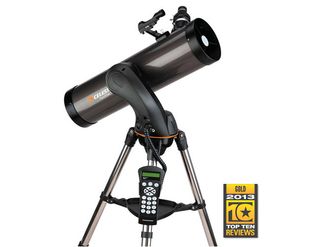Andromeda Galaxy Glitters in Spectacular Photo by Astrophotographer

A huge number of stars shine brightly in an amazing skywatcher photo of the Andromeda Galaxy.
André van der Hoeven, a photographer based in the Netherlands, captured the image. It took van der Hoeven about 9.6 hours to complete the new photo of Andromeda, which was reprocessed since it was initially taken in September.
"The galaxy came out quite a lot better in this new image," van der Hoeven told Space.com of the reprocessed image.
Scientists think that the Andromeda galaxy (also called M31) will eventually merge with the Milky Way in about 4 billion years from now. Andromeda is located about 2.5 million light-years from the Milky Way and it is the largest galaxy in the galactic group where they are located. The merging of the two galaxies will likely create one large, elliptical galaxy unlike the Milky Way's current spiral shape.
Now is the time to see Andromeda in the night sky, according to Starry Night Education's Geoff Gaherty. Draw a line straight out from the right-hand part of the "W" of the constellation Cassiopeia and you should find M31 glowing like a faint-fuzzy splotch in the sky, Gaherty wrote in a November skywatching guide.

"Andromeda is so far away that its trillion stars combine to make a very faint glowing patch. You can see this most easily with binoculars," Gaherty said. "Once you spot it, however, if you have a dark sky, you should be able to see it with your unaided eye."
Many amateur astronomers find it easier to spot Andromeda in binoculars rather than through a telescope. The telescope's field of view isn't wide enough to capture the entire galaxy, Gaherty added.
Get the Space.com Newsletter
Breaking space news, the latest updates on rocket launches, skywatching events and more!
You can see more of van der Hoeven's astrophotgraphy at his website here: www.astro-photo.nl.
Editor's Note: If you have an amazing image of Andromeda or any other night sky object or any other skywatching photo you'd like to share for a possible story or image gallery, please contact managing editor Tariq Malik at spacephotos@space.com.
Follow Miriam Kramer @mirikramer. Follow us @Spacedotcom, Facebook and Google+. Original article on Space.com.
Join our Space Forums to keep talking space on the latest missions, night sky and more! And if you have a news tip, correction or comment, let us know at: community@space.com.

Miriam Kramer joined Space.com as a Staff Writer in December 2012. Since then, she has floated in weightlessness on a zero-gravity flight, felt the pull of 4-Gs in a trainer aircraft and watched rockets soar into space from Florida and Virginia. She also served as Space.com's lead space entertainment reporter, and enjoys all aspects of space news, astronomy and commercial spaceflight. Miriam has also presented space stories during live interviews with Fox News and other TV and radio outlets. She originally hails from Knoxville, Tennessee where she and her family would take trips to dark spots on the outskirts of town to watch meteor showers every year. She loves to travel and one day hopes to see the northern lights in person. Miriam is currently a space reporter with Axios, writing the Axios Space newsletter. You can follow Miriam on Twitter.
